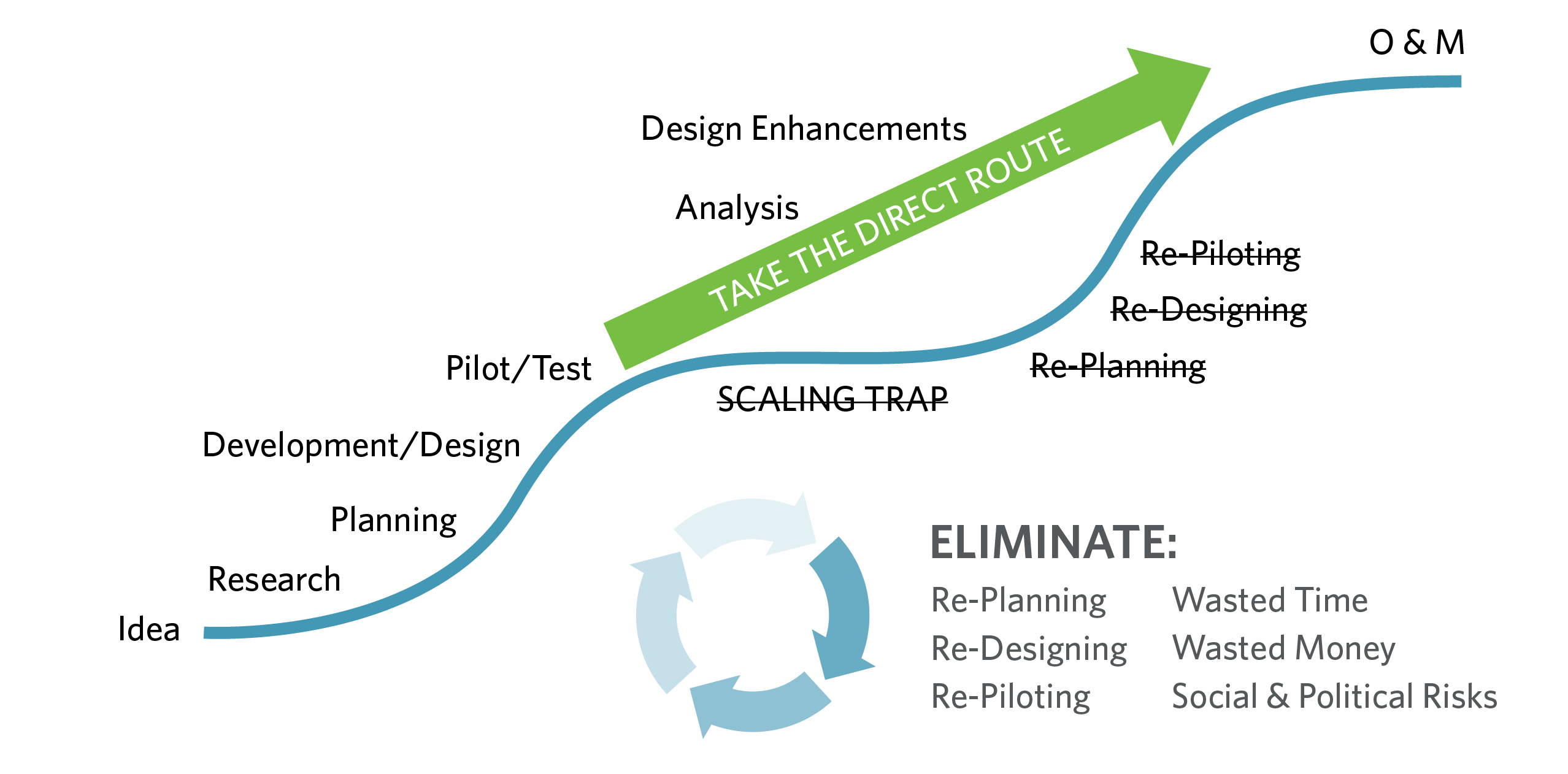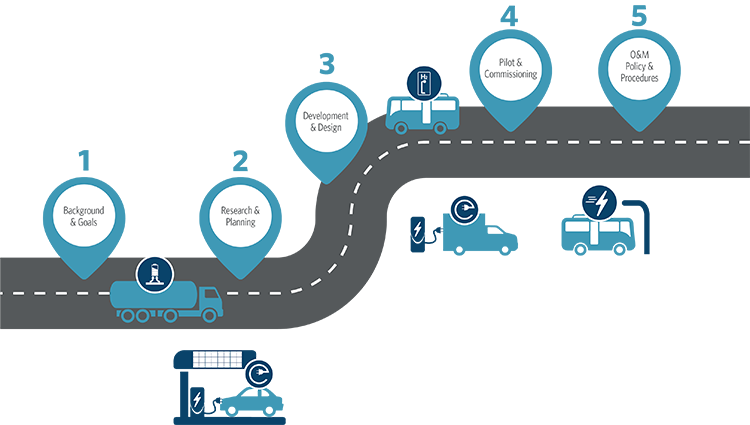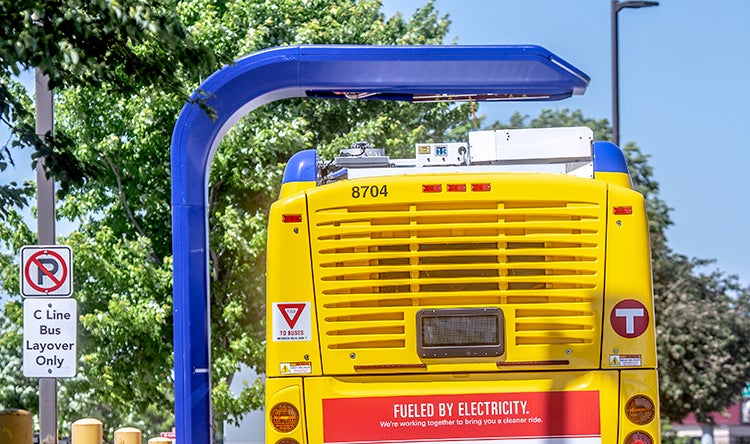Planning the Right Zero-Emission Fleet Conversion from the Beginning
A Clear Roadmap for Adapting to New Technology Will Avoid Missteps in the Transition to Zero-Emission Fleets
A version of this article was originally published in Mass Transit magazine.
Imagine the start of a triathlon. The starting gun goes off and everybody dives into the water. After the swim, some participants jump out and grab their bicycles for the next phase while others look around sheepishly and ask “We needed a bike?”
That failure to plan ahead is farfetched, but it shows what happens when there’s a fundamental misunderstanding of the bigger picture and the end goal. Many fleet operators make a similar misstep in their transition to zero-emission vehicles. They start off too quickly or leap to an easy partial solution, then have to head back to the starting line after completing the pilot project. In a multi-part, data driven undertaking, it’s important to prepare for all of the phases from the beginning. Yes, transition plans are phased approaches that can cover multiple years, but a clear roadmap for adapting to new technology makes much more sense than returning to the starting line every time.
Globally, about half of the world's buses will be battery-powered by 2032, according to BloombergNEF research. Fleet owners across the U.S. and Canada are considering or actively pursuing a transition to zero emissions vehicles. More than 200 transit agencies in North America are operating, ordering or have received funding for zero-emissions vehicles. Many others are paying close attention. Installing a charging station and purchasing a handful of buses to replace those on current routes is an easy way to start. However, developing a comprehensive roadmap at the beginning of the process is a much more effective and efficient way to transition to zero emissions vehicles.
Developing the right strategy for a fleet transition means developing long-term goals and strategies, whether that’s whole-fleet conversion, a specific emissions target or some other strategic goal. Skipping the research, planning and design steps at the start may seem like a time saver, but in reality, it leads to one of the biggest causes of lost time and money for fleet owners pursuing this transition, the scaling trap, illustrated below.
First Things First: Avoid the Scaling Trap

As with any effort involving new technology, a transition to zero emissions vehicles will take operators through a technology adaptation S-curve, from idea to plan to design to pilot to full implementation. Every step is important, necessary and builds on the previous step. But this simple S-curve is not what we’re seeing in many cases. Instead, roll-out programs start and stall, struggling to scale to full adoption, resulting in a double or triple S-curve scaling trap causing pitfalls and re-starts.
The scaling trap is the place agencies find themselves when they’ve completed a pilot project, are ready to move on to the next phase, then realize they are unclear on what needs to happen next and unsure whether they have the resources or infrastructure to move forward. This often happens as a result of projects that were designed to test technology or utilize an available funding source vs. being a smaller strategic element of a strategic, community-focused roadmap.
This piecemeal approach leads to more work and additional investments. This stalls progress, frustrates stakeholders, impacts employee morale and drains budgets. Taking the time to lay a solid foundation focusing pilot projects on testing for the end result is key to avoiding this trap, saving fleet owners time and money, and minimizing the social and political risk that comes with overpromising to transit board members and setting up unrealistic community expectations.
The question fleet owners must confront is, “what is my pilot program testing?” A well-considered approach that pays long dividends will test the energy delivery system and vehicle solutions that will be used for an entire fleet, not just the first few vehicles. That might mean, for instance, utilizing a depot charger and/or en-route charger to test the impacts of both solutions on operations, workforce, planning and finance. Making smart early investments will pay off as a conversion plan is phased in.
Starting with a holistic, system-wide approach focused on the end goal means gathering all the relevant data and research at the beginning. This includes the pros and cons, as well as the operating and financial implications needed to make good decisions. With that solid foundation, design and development can move forward and the resulting pilot project is actually a validation of the end goal. If the plan is to store vehicles in a certain way and charge them in a certain way, then the pilot should be a test of that solution. If it works, the project can increase in scale and move forward, without circling back to the research stage.
A Better Roadmap, From Idea to Implementation

Any owners converting their fleets should expect the process to happen in phases, as current vehicles end their service life, battery electric or hydrogen fuel cell infrastructure is added and funding becomes available. Conversion plans should also remain flexible and ready to adapt to new technology as it is developed and rolled out.
HDR has worked with a number of clients to study the power and infrastructure needs of fleet conversions and draft plans for making this switch, including requirements for an initial rollout and the upgrades needed for additional long-term capacity. Starting with longer-range planning in mind means facilities and infrastructure can be sized with future needs in mind, minimizing repeated studies, plans and construction.
A clear roadmap from start to finish requires a firm grasp of all of the factors, including:
Utility collaboration: Get the local utilities involved as soon as possible. Managing electric demand and availability are critical considerations when designing charging infrastructure to support cost effective, reliable fleet operations, as is understanding the rate structure of the local electric utility. EV fleet loads are new to the electric utility industry, so ongoing communication is imperative. Key to this communication is having experts who know not only the needs of electric vehicle owners, but who “talk utility,” who understand the utility industry and know the right questions to ask. Providing utilities with robust, accurate data can help keep initial infrastructure costs down by helping them understand the specific charging requirements. Phasing in the electric fleet also allows the utility time to respond and react to the fleet electric load. Some utilities will offer special rates for large-scale projects like electric fleets, but those rates can take years to program and implement.
Route feasibility: With different energy needs and capacity, zero emissions vehicles may require adjusting routes, schedules or an en-route charging strategy. It’s important to consider the impact to community, facility and stop locations, vehicle duty cycles and more. A phased transition can often be beneficial, focusing first on routes that are easy to transition to build momentum and create early successes. Then a second wave of more complicated routes can be transitioned, perhaps requiring new schedules or slight modifications to routes. Finally, the most complex routes can be tackled, those which may require new facility locations or multiple zero emissions vehicles to replace conventional vehicles. This phased approach has the advantage of giving technology time to advance and perhaps solve some of the problems that make the more complex routes more difficult.
Total cost of ownership: Converting a fleet to new technology is expensive, with costs in multiple areas: New vehicles, new infrastructure, retraining workforce and more. Understanding and planning for all of the startup costs is important to avoid unpleasant budget surprises. At the same time, discussions of costs should take a long view. After startup expenses, ongoing operations costs are generally lower. A solid plan will be able to calculate the return on investment timeframe.
Sustainability: Creating a cost-effective, energy-efficient and sustainable investment requires looking beyond just economics to the “triple-bottom line”: environmental, social and economic impacts. Studying all of these and how they relate to each other provides a holistic perspective of a project’s sustainability benefits. Understanding these factors means longer-term viability, reduced risk, lower cost, better value, fewer negative impacts on the community and the potential to save owners money over time.

Decisions Driven by Data
Modeling programs and complex analyses can account for all of these factors as well as route feasibility and more to help agencies and their electric utility partners reach informed, data-driven decisions about the best path forward.
HDR’s Zero+ Fleet Optimizer modeling tool, for example, can produce detailed data about a proposed system’s energy consumption and the information needed to complete a comprehensive operational analysis or sustainability reports. Our EconMoves modeler can evaluate and compare implementation, costs and funding scenarios to help clients determine the best fit for their needs. Together, the two tools can create realistic scenarios to help forecast the financial and energy needs of a system.
For example, we’ve used our GIS-based Zero+ Fleet Optimizer tool to digitally represent clients’ transit networks and simulate every bus trip, to determine the power demands of specific electric bus models and the charging strategies to accomplish a system’s desired transition. The modeling can also include information on effective route schedules, fleet size estimates, managed vs. unlimited charging, vehicle duty cycles and more. All of this data helps agencies make informed decisions from the beginning about how to proceed with transitions.
Successful Transition
Planning for transition from the very start is the way to avoid the pitfalls of the “scaling zone.” Functional analyses and incremental decision-making will result in a successful transition plan. A well-thought-out roadmap leads to less wasted time and investments, helps garner public and political support and shows all stakeholders there is a comprehensive plan for not just the near future, but the long term.
About the Author
Rob Mowat is HDR’s Zero Emissions Mobility Practice Lead and has more than 30 years of experience in the transportation industry. His expertise in new transit technology transitions has resulted in multiple successful deployments of fleet electrification and modernization.




